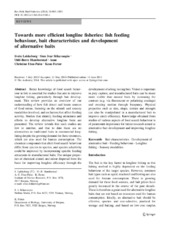| dc.contributor.author | Løkkeborg, Svein | eng |
| dc.contributor.author | Siikavuopio, Sten Ivar | eng |
| dc.contributor.author | Humborstad, Odd Børre | eng |
| dc.contributor.author | Utne-Palm, Anne Christine | eng |
| dc.contributor.author | Ferter, Keno | eng |
| dc.date.accessioned | 2015-03-18T14:08:57Z | |
| dc.date.available | 2015-03-18T14:08:57Z | |
| dc.date.issued | 2014-12 | eng |
| dc.identifier.issn | 0960-3166 | en_US |
| dc.identifier.uri | https://hdl.handle.net/1956/9586 | |
| dc.description.abstract | Better knowledge of food search behavior in fish is essential for studies that aim to improve longline fishing, particularly through bait development. This review provides an overview of our understanding of how fish detect and locate sources of food odour, focusing on the stimuli and sensory modalities involved, and on factors that affect feeding activity. Studies that identify feeding attractants and efforts to develop alternative longline baits are presented. The review reveals that such studies are few in number, and that to date there are no alternatives to traditional baits in commercial longlining despite the growing demand for these resources, which are also used for human consumption. The chemical compounds that elicit food search behavior differ from species to species, and species selectivity could be improved by incorporating specific feeding attractants in manufactured baits. The unique properties of chemical stimuli and odour dispersal form the basis for improving longline efficiency through the development of a long-lasting bait. Vision is important in prey capture, and manufactured baits can be made more visible than natural baits by increasing the contrast (e.g. via fluorescent or polarising coatings) and creating motion through buoyancy. Physical properties such as size, shape, texture and strength can also be manipulated in a manufactured bait to improve catch efficiency. Knowledge obtained from studies of various aspects of food search behaviour is of paramount importance for future research aimed at alternative bait development and improving longline fishing. | en_US |
| dc.language.iso | eng | eng |
| dc.publisher | Springer | en_US |
| dc.rights | Attribution CC BY | eng |
| dc.rights.uri | http://creativecommons.org/licenses/by/4.0 | eng |
| dc.subject | Bait characteristics | eng |
| dc.subject | Development of alternative bait | eng |
| dc.subject | Feeding behaviour | eng |
| dc.subject | Longline fishing | eng |
| dc.subject | Sensory modalities | eng |
| dc.title | Towards more efficient longline fisheries: fish feeding behaviour, bait characteristics and development of alternative baits | en_US |
| dc.type | Peer reviewed | |
| dc.type | Journal article | |
| dc.date.updated | 2015-03-05T08:00:49Z | en_US |
| dc.description.version | publishedVersion | en_US |
| dc.rights.holder | Copyright 2014 The Authors | en_US |
| dc.identifier.doi | https://doi.org/10.1007/s11160-014-9360-z | |
| dc.identifier.cristin | 1140016 | |
| dc.source.journal | Reviews in Fish Biology and Fisheries | |
| dc.source.40 | 24 | |
| dc.source.14 | 4 | |
| dc.source.pagenumber | 985-1003 | |
| dc.relation.project | Egen institusjon: 20940 | |
| dc.relation.project | Nofima AS: 10329 | |
| dc.relation.project | Fiskeri- og havbruksnæringens forskningsfond: 900781 | |
| dc.subject.nsi | VDP::Agriculture and fisheries science: 900::Fisheries science: 920::Catch: 925 | en_US |
| dc.subject.nsi | VDP::Landbruks- og fiskerifag: 900::Fiskerifag: 920::Fangst: 925 | nob |

